Казанлъшка гробница
Kazanluk Tomb - The Thracian Tomb of Kazanluk - Kazanlak Tomb
Useful Information
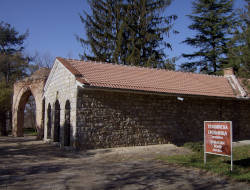
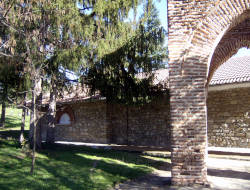
| Location: |
Park Tylbe, Kazanlak.
Parking: 48 General Radetski, Kazanlak. 200 km east of Sofia, 55 km east of Karlovo, 48 km south of Gabrovo and 75 km west of Sliven. (42.626081, 25.399824) |
| Open: |
All year daily 9-17. [2021] |
| Fee: |
Adults BGN 6, Children (7-16) BGN 2, Children (0-6) free. Guide BGN 5, Foreign Language BGN 10. Free admission every last Mon of the month. [2021] |
| Classification: |
 Cave Tomb Cave Tomb
 Painted Cave Replica Painted Cave Replica
|
| Light: |
 Electric Light Electric Light
|
| Dimension: | |
| Guided tours: | |
| Photography: | |
| Accessibility: | |
| Bibliography: | |
| Address: |
Museum of History Iskra-Kazanlak, 9, St Cyril and St Methodius str., 6100 Kazanlak, Tel: +359-431-64750.
E-mail: |
| As far as we know this information was accurate when it was published (see years in brackets), but may have changed since then. Please check rates and details directly with the companies in question if you need more recent info. |
|
History
| 3rd century | built. |
| 09-APR-1944 | accidentally discovered by soldiers while digging an anti-aircraft shelter. |
| 1948-1954 | ancient city Seuthopolis excavated. |
| 1979 | inscribed on the UNESCO World Heritage List. |
| 26-FEB-2013 | tomb closed to the public in order to protect the paintings. |
Description
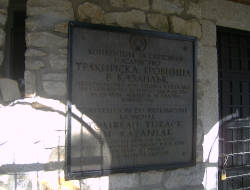
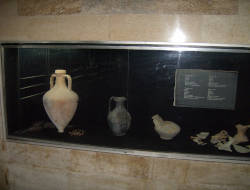
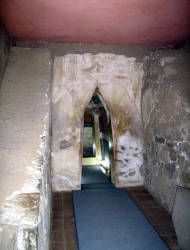
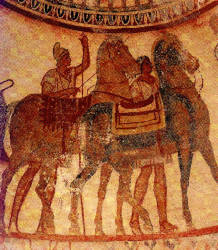
The Казанлъшка гробница (Kazanluk Tomb) in south Bulgaria is of the beehive type and famous for its beautiful wall paintings. The unique murals, done in wet fresco and tempera, show battles and scenes from daily life. The pictures are very realistic and show many details of clothing and armour.
The tomb is part of a large royal Thracian necropolis near their ancient capital of Seuthopolis. In the Valley of the Thracian Rulers more than a thousand tombs of kings and members of the Thracian aristocracy can be found. The name was coined by the archaeologist Georgi Kitov, because of the extremely high concentration and variety of monuments. There are estimates that the valley contains over 1500 tumuli, only 300 have been researched so far, between the 1960s and the 1980s. In 1965, two brick tombs, the Maglizh and Kran tombs were discovered. Prof L. Getov excavated the thracian tombs from the Roman era in the regions of the villages of Tulovo and Dabovo. Dr. M. Domaradski researched the village of Tazha and the surrounding necropolis in the Atanastsa region. Between 1992 and 2006 Senior Research associate Dr. G. Kitov led the Thracian Expedition for Mound Research (TEMR) and studied over 200 mounds. Many funeral practices of the Thracians during the Iron and Roman Eras in the Kazanlak Valley were studied.
The tomb is not open to the public, in order to protect the fragile paintings. Similar to the famous painted caves, a replica was built nearby and is open to the public. The pictures on this page are from the replica.
The known tombs in the area were discovered during archaeological excavations in the 1980s and around 2000. This is a good thing, as they are very well preserved and no archaeological remains were destroyed by early "explores", grave robbers, or souvenir hunters. However, this grave is the big exception. It was the first which was discovered, and it was an accident. During World War II, on April 19, 1944, soldiers were digging an anti-aircraft shelter. Why they thought the mound would be a good place remains unknown though.
The underground structure was erected at the level of the surrounding terrain and later covered by a mound. The passage is oriented north-south, the entrance is from the south. There is a corridor first, then a rectangular tomb, and finally a round burial chamber. The corridor is rather big, 1.84 m wide and 2.60 m high, but only 2 m long. The rectangular tomb measures 1.12 m by 1.96 m and is 2.25 m high. The domed burial chamber is 2.65 m in diameter and 3.25 m high. The corridor was made of untreated stones while the two chambers were made of bricks welded with mortar. The chambers walls, floors and ceiling are covered with three layers of plaster.
The walls and the domes are covered by colourful paintings in tempera and fresco techniques. The wall plaster is divided into several colored belts in white, black and red. Above are two friezes with ornaments. On the top is a figural frieze with war scenes. The center of each scene is highlighted by a pair of warriors, joined on either side by armed infantrymen and galloping horsemen. They are dressed in short chitons, flat shoes, and red and blue scarves flutter on their shoulders. Their armament includes helmets, pairs of short spears, large shields, and long curved swords called mahairs The scenes are interpreted either as events in the life of the deceased or depictions of commemorative games which were held in his memory.
The entrance to the dome is rectangular and made of four huge stone blocks. It was once closed by a single-leaf metal door. Again the lower half of the wall is covered by alternating fields of black, white and red. The architrave is crowned alternately by twelve four-petalled rosettes and twelve garlanded bull’s heads. The main frieze in the cupola shows three central figures. A noble Thracian, crowned with a golden wreath, sitting on a low wedge. His wife, with a tiara on her head, covered with a veil, sitting on a high chair. And finally a large straight woman in peplos approaching them with a tray in her hands. This scene is interpreted as funeral feast. The group is surrounded by a procession marching on both sides. The right group includes a young man carrying a cup and a jug in his hands, two musicians in long chitons, and two warriors leading saddled horses. The left group starts with a woman in a long chiton, carrying a box in one hand and a rectangular chest in the other. A second woman follows with a light blue cloak in her hands. Then a young man follows, leading four horses with a cart. After more frieses, the paintings end with a race with chariots pulled by two horses.
- See also
 Subterranean World Heritage List
Subterranean World Heritage List Search DuckDuckGo for "Kazanluk Tomb"
Search DuckDuckGo for "Kazanluk Tomb" Google Earth Placemark
Google Earth Placemark Thracian Tomb of Kazanlak - Wikipedia
Thracian Tomb of Kazanlak - Wikipedia Kazanlak Tomb, official website (visited: 27-SEP-2021)
Kazanlak Tomb, official website (visited: 27-SEP-2021) Thracian Tomb of Kazanlak
Thracian Tomb of Kazanlak UNESCO Kazanluk Tomb
UNESCO Kazanluk Tomb The Tracian Tomb In Kazanluk
The Tracian Tomb In Kazanluk Treasure Quest : Thracian Tomb of Kazanlak
Treasure Quest : Thracian Tomb of Kazanlak
 Index
Index Topics
Topics Hierarchical
Hierarchical Countries
Countries Maps
Maps